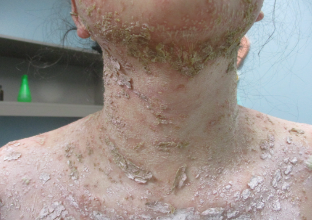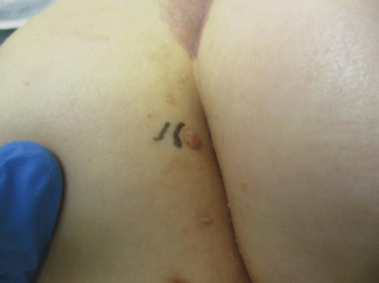CORRECT DIAGNOSIS:
Gardner-Diamond Syndrome
DISCUSSION:
Gardner Diamond Syndrome, also known as psychogenic purpura or autoerythrocyte sensitization, is a rare disorder characterized by the spontaneous or induced development of painful purpuric lesions. First described by Gardner and Diamond in 1955, this syndrome has been the subject of various studies and discussions due to its unique presentation and complex etiology.
The term “autoerythrocyte sensitization” derives from the observation that some patients react to intradermal injections of their own erythrocytes. This reaction suggests the possible presence of autoantibodies against phosphatidylserine, a phospholipid component of erythrocyte membranes. However, it is important to note that this reaction is not universally present among patients, which limits its utility as a definitive diagnostic criterion. The initial cases documented by Gardner and Diamond highlighted the rapid progression of edematous and erythematous lesions following trauma, ultimately leading to painful purpura.
Typically affecting young females, Gardner Diamond Syndrome is characterized by the spontaneous or induced development of painful, edematous, atypical purpuric lesions that vary in size. These lesions are most commonly seen on the lower legs, although involvement of other sites has been documented. One of the hallmark features of this syndrome is the resolution of lesions within a two-week period, followed by a tendency for recurrence. In addition to skin manifestations, patients often report a range of associated symptoms, including abdominal pain, nausea, vomiting, diarrhea, and headaches.
The exact etiology of Gardner Diamond Syndrome remains unclear, although several associations have been reported. Underlying psychiatric conditions, such as anxiety, depression, borderline personality disorder, and difficulties in managing aggression and hostility, are frequently noted among affected individuals. Furthermore, a preceding traumatic event—such as a medical procedure or surgery occurring up to two years before the onset of symptoms—may trigger the syndrome. Severe psychosocial stressors, including marital conflicts or the illness or death of a family member, have also been implicated.
Diagnosing Gardner Diamond Syndrome involves a thorough laboratory workup to exclude potential hematologic or autoimmune causes. Essential tests include a complete blood count (CBC) with platelet count, peripheral blood smear, prothrombin time, and partial thromboplastin time. Skin biopsy typically reveals extravasated red blood cells without key features suggesting vasculitis. Consequently, the diagnosis is primarily clinical, relying on characteristic presentation and the exclusion of other precipitating factors—be they hematologic, vascular, immunologic, or infectious in nature.
TREATMENT:
Gardner Diamond Syndrome presents significant challenges in treatment, primarily due to its complex interplay of psychological and physical factors. Effective management requires a comprehensive approach focused on the underlying psychiatric conditions. While some patients have found relief from antihistamines, it is important to recognize that these do not address the core disorder. Instead, they may provide only temporary symptomatic relief. On the other hand, corticosteroids and immunosuppressive agents have been attempted but have not demonstrated effectiveness in managing the symptoms of Gardner Diamond Syndrome.
In our case, the patient had been seeing a pain management specialist but discontinued those visits after noticing no improvement in her symptoms. Currently, she is under the care of a psychiatrist, having recently started SSRIs to help manage her mental health. Furthermore, a nerve study is pending with neurosurgery to explore any additional neurological factors that may be contributing to her condition. She is scheduled for a follow-up appointment in three months, which will allow for ongoing assessment of her treatment response and adjustments as necessary. This multidisciplinary approach aims to provide a more holistic treatment strategy, addressing both the psychological and physical aspects of Gardner Diamond Syndrome.
CONCLUSION:
Gardner Diamond Syndrome, also known as psychogenic purpura or autoerythrocyte sensitization, is a rare disorder characterized by spontaneous or induced painful purpuric lesions, primarily affecting young females. First described by Gardner and Diamond in 1955, the condition often follows trauma and is associated with underlying psychiatric issues, traumatic events, and psychosocial stress.
Our patient, a 30-year-old female, has experienced these painful lesions and has sought treatment from various specialists. Despite undergoing pain management, she discontinued those visits due to a lack of improvement. Currently, she is seeing a psychiatrist and has recently started selective serotonin reuptake inhibitors (SSRIs). A nerve study is pending with neurosurgery to further evaluate her condition.
Management of Gardner Diamond Syndrome remains challenging, emphasizing the need for long-term treatment of psychiatric conditions through psychotherapy and SSRIs. While antihistamines may provide some symptomatic relief, corticosteroids and immunosuppressive agents have shown little effectiveness. A comprehensive approach is essential for optimizing patient outcomes.
REFERENCES:
Gardner, F. H., & Diamond, L. K. (1955). Autoerythrocyte sensitization; a form of purpura producing painful bruising following autosensitization to red blood cells in certain women. Blood, 10(7), 675-690. doi:10.1182/blood.V10.7.675. [PMID: 14363785]
Suh, H. H., & Meller, A. (2016). Psychogenic purpura: A case report and literature review. Dermatology Reports, 8(1), 6558. doi:10.4081/dr.2016.6558. [PMID: 27004077]
Pinto, R. S., & Dos Santos, L. P. (2018). Autoerythrocyte sensitization syndrome: A literature review. The Clinical Respiratory Journal, 12(5), 2035-2039. doi:10.1111/crj.12738. [PMID: 29087873]
Meyer, R., & Wilke, G. (2015). Gardner Diamond syndrome: A review of the literature. Journal of Dermatological Treatment, 26(3), 263-266. doi:10.3109/09546634.2014.970843. [PMID: 25237337]
García-Hernández, M. J., et al. (2018). Management of Gardner Diamond syndrome: A clinical review. Journal of Dermatological Treatment, 29(6), 658-661. doi:10.1080/09546634.2018.1433176. [PMID: 29396074]
Bolognia, J. L., Schaffer, J. V., & Cerroni, L. (2018). Dermatology. Elsevier.
Ivanov, O. L., et al. (2009). Autoerythrocyte sensitization syndrome (Gardner-Diamond syndrome): Review of the literature. Journal of the European Academy of Dermatology and Venereology, 23(5), 499-504. doi:10.1111/j.1468-3083.2008.02903.x. [PMID: 19016986]
Thokchom, N. S., Pradeepa, D., Hafi, N. A. B., & Verma, K. (2018). Clinical spectrum of autoerythrocyte sensitization syndrome: A series of five cases. Indian Dermatology Online Journal, 9(2), 110-113. doi:10.4103/idoj.IDOJ_81_17. [PMID: 29732004]
Block, M. E., Sitenga, J. L., Lehrer, M., & Silberstein, P. T. (2019). Gardner-Diamond syndrome: A systematic review of treatment options for a rare psychodermatological disorder. International Journal of Dermatology, 58(7), 782-787. doi:10.1111/ijd.14325. [PMID: 30836407]
Sridharan, M., Ali, U., Hook, C. C., Nichols, W. L., & Pruthi, R. K. (2019). The Mayo Clinic experience with psychogenic purpura (Gardner-Diamond syndrome). American Journal of Medical Sciences, 357(5), 411-420. doi:10.1016/j.amjms.2019.01.009. [PMID: 30801535]
Piette, W. W. (2017). Purpura: Mechanisms and differential diagnosis. In J. L. Bolognia, J. V.
Schaffer, & L. Cerroni (Eds.), Dermatology (4th ed.). Philadelphia, PA: Elsevier.




